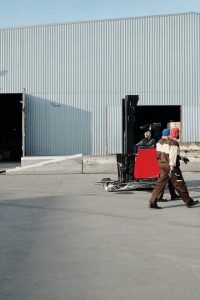
Why Is An Unloaded Forklift Sometimes Unstable
Forklifts are indispensable tools in various industries, enabling the efficient movement and lifting of heavy loads. These powerful machines are designed to handle substantial weights safely and smoothly. However, it is essential to understand that forklift stability can be compromised when operating with an empty load.
So why is an unloaded forklift sometimes unstable? Read more we will delve into the reasons of this topic and exploring factors such as weight distribution, center of gravity, and operational considerations.
The Common Reasons Why Is An Unloaded Forklift Sometimes Unstable

- Weighty Distribution
One of the primary reasons for an unloaded forklift’s instability lies in its weight distribution. Forklifts are typically designed with counterweights at the rear to balance the load being lifted. When the forklift or lift truck is empty, there is no load to counterbalance the weight at the front, leading to an uneven weight distribution between the front and rear axles. This uneven distribution can cause the forklift to feel top-heavy and prone to tipping forward, especially during acceleration or sudden stops.
- Center Of Gravity And Forklift Stability Triangle
The center of gravity plays a crucial role in determining the stability of any object, including forklifts. The center of gravity refers to the point where the entire weight of the forklift is concentrated. In an unloaded forklift, the center of gravity tends to shift towards the front due to the absence of a heavy load at the back. This shift increases the likelihood of the forklift tipping forward, especially when the operator maneuvers on uneven surfaces, slopes, or when making sharp turns. That is why it’s important that the operator must learn about the stability triangle and know where to keep the center of gravity at all times.
- Impact Of Operational Considerations
Apart from weight distribution and the center of gravity, several operational aspects can contribute to the instability of an unloaded forklift. Let’s explore some of these considerations:
Operator Behavior
A forklift operator plays a critical role in ensuring the stability of the vehicle. Abrupt movements, excessive acceleration, or sudden braking can destabilize an unloaded forklift. It is crucial for operators to exercise caution and follow safe operating practices when they operate a forklift at all times.
Surface Conditions
Uneven or slippery surfaces can increase the likelihood of an unloaded forklift tipping over. Gravel, ice, oil spills, or other hazards can compromise traction and reduce overall stability. Operators must be vigilant and adapt their driving techniques accordingly.
Speed
Excessive speed is another factor that can contribute to instability, especially when the forklift is empty. Higher speeds can make it more challenging to control the forklift, particularly during turns or sudden changes in direction. Operators should always maintain a safe and controlled speed to ensure stability.
Fork Positioning
Improperly positioned forks can affect the balance of an unloaded forklift. If the forks are raised too high or tilted forward, it can shift the center of gravity and make the forklift more susceptible to tipping. Operators must ensure that the forks are properly positioned to maintain stability.
- Importance Of Load Handling For Forklift Stability
While an unloaded forklift may pose stability challenges, it is crucial to understand that these machines are designed to handle loads safely. The counterbalance provided by the weight of the load plays a significant role in stabilizing the forklift. When the forklift is carrying a load, the weight distribution shifts, and the center of gravity moves towards a more balanced position, enhancing stability.
Tips In Maintaining A Forklift Machine And Forklift Safety
Here are some tips to follow to ensure your forklift machine is in optimal operating condition:
- Regular Inspection Of Tires
Check your forklift tires regularly for signs of damage or wear and tear. If the tires are in poor condition, replace them promptly to maintain stability.
- Check Fork Position
Ensure that your forks are properly positioned according to the load’s weight and size. Improper positioning can destabilize an unloaded forklift.
- Maintain Speed
Always maintain a safe operating speed to minimize the risk of an accident. Pay close attention to surface conditions and adjust your speed accordingly.
- Follow Manufacturer’s Guidelines
Read and understand the operator manual for your forklift model. Ensure that all safety measures are followed when operating the machine, including those related to loading, unloading, and stabilizing.
- Check The Parts
Make sure that all components of the forklift machine are in good working order. Monitor the brakes, steering mechanism, and hydraulics for any signs of deterioration or wear and tear.
If you see any broken parts in your forklift, you need to replace them immediately. You can purchase forklift parts from Watts Equipment California as they offer a wide selection of quality parts at competitive prices.
Conclusion
An unloaded forklift may be prone to instability due to the uneven weight distribution, shifted center of gravity, and operational considerations. It is essential to take preventive measures like regular inspection of tires, proper positioning of forks, maintaining speed limits, following manufacturer’s guidelines, and replacing broken parts when necessary.
Following these steps can help protect you, your forklift, and the people around you. Watts Equipment California is an ideal destination for buying quality forklift parts at competitive prices.